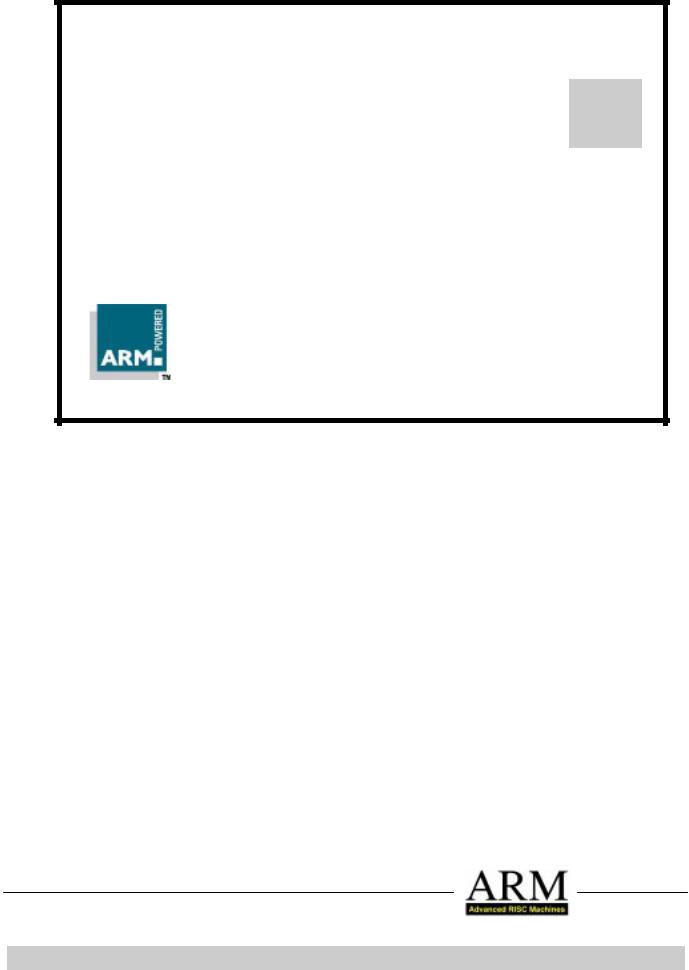
(ARM).Floating-point performance
.pdf
Application Note 55
Floating-Point Performance
Document number: ARM DAI 0055A
Issued: January 1998
Copyright Advanced RISC Machines Ltd (ARM) 1998
ENGLAND |
|
|
GERMANY |
|
||
Advanced RISC Machines Limited |
Advanced RISC Machines Limited |
|||||
Fulbourn Road |
|
|
Otto-Hahn Str. 13b |
|
||
Cherry Hinton |
|
|
85521 Ottobrunn-Riemerling |
|||
Cambridge CB1 4JN |
|
Munich |
|
|
||
UK |
|
|
|
Germany |
|
|
Telephone: |
+44 |
1223 400400 |
Telephone: |
+49 89 608 75545 |
||
Facsimile: |
+44 |
1223 400410 |
Facsimile: |
+49 89 608 75599 |
||
Email: |
info@arm.com |
Email: |
info@arm.com |
|||
JAPAN |
|
|
|
USA |
|
|
Advanced RISC Machines K.K. |
ARM USA Incorporated |
|||||
KSP West Bldg, 3F 300D, 3-2-1 Sakado |
Suite 5 |
|
|
|||
Takatsu-ku, Kawasaki-shi |
985 University Avenue |
|||||
Kanagawa |
|
|
Los Gatos |
|
||
213 Japan |
|
|
CA 95030 USA |
|
||
Telephone: |
+81 |
44 850 1301 |
Telephone: |
+1 408 399 5199 |
||
Facsimile: |
+81 |
44 850 1308 |
Facsimile: |
+1 408 399 8854 |
||
Email: |
info@arm.com |
Email: |
info@arm.com |
|||
World Wide Web address: http://www.arm.com
Open Access

Proprietary Notice
ARM and the ARM Powered logo are trademarks of Advanced RISC Machines Ltd.
Neither the whole nor any part of the information contained in, or the product described in, this document may be adapted or reproduced in any material form except with the prior written permission of the copyright holder.
The product described in this document is subject to continuous developments and improvements. All particulars of the product and its use contained in this document are given by ARM in good faith. However, all warranties implied or expressed, including but not limited to implied warranties or merchantability, or fitness for purpose, are excluded.
This document is intended only to assist the reader in the use of the product. ARM Ltd shall not be liable for any loss or damage arising from the use of any information in this document, or any error or omission in such information, or any incorrect use of the product.
Key
Document Number
This document has a number which identifies it uniquely. The number is displayed on the front page and at the foot of each subsequent page.
ARM |
XXX |
0000 |
X |
- 00 |
(On review drafts only) Two-digit draft number
Release code in the range A-Z
Unique four-digit number
Document type
Document Status
The document’s status is displayed in a banner at the bottom of each page. This describes the document’s confidentiality and its information status.
Confidentiality status is one of:
ARM Confidential |
Distributable to ARM staff and NDA signatories only |
Named Partner Confidential |
Distributable to the above and to the staff of named partner companies only |
Partner Confidential |
Distributable within ARM and to staff of all partner companies |
Open Access |
No restriction on distribution |
Information status is one of: |
|
Advance |
Information on a potential product |
Preliminary |
Current information on a product under development |
Final |
Complete information on a developed product |
Change Log
Issue |
Date |
By |
Change |
A |
January 1998 |
SKW |
Released |
|
Application Note 55 |
ii |
ARM DAI 0055A |
Open Access

Table of Contents
Table of Contents
1 |
Introduction |
2 |
|
2 |
Floating-Point Systems |
3 |
|
|
2.1 |
Hardware floating-point systems |
3 |
|
2.2 |
Software floating-point systems |
4 |
|
2.3 |
Floating-point system selection when compiling |
6 |
3 Hardware, Software and Benchmarks Used |
7 |
||
4 |
Floating-Point Performance of Selected Systems |
8 |
|
5 |
Improving Floating-Point Performance |
9 |
|
|
5.1 |
General techniques for optimizing floating-point code |
9 |
|
5.2 |
Optimizing floating-point code for the FPA11 |
10 |
|
5.3 |
Optimizing floating-point code for the FPE |
11 |
6 |
Example: Optimizing the Linpack Inner Loop |
12 |
|
Application Note 55
ARM DAI 0055A |
1 |
Open Access

Introduction
1 Introduction
There are a number of different floating-point options on ARM systems, including:
∙Hardware coprocessors that execute a floating-point instruction set.
∙Software emulation of these hardware coprocessors.
∙A software library that implements floating-point arithmetic functions.
These represent various different trade-offs between floating-point performance, system cost and system flexibility. The purpose of this Application Note is to detail these trade-offs and provide an indication of the performance available from each option.
Some guidance is also provided about performance tuning of critical sections of floatingpoint code, with an example.
Other documentation about ARM floatingand fixed-point systems can be found in:
∙Software Development Toolkit User Guide (ARM DUI 0040) Chapter 15 Floating-
Point Support
∙Application Note 23: The ARM Floating-Point Emulator (ARM DAI 0023)
∙Application Note 33: Fixed-Point Arithmetic on the ARM (ARM DAI 0033)
∙Application Note 40: Configuring the FPA Support Code/FPE (ARM DAI 0040)
|
Application Note 55 |
2 |
ARM DAI 0055A |
Open Access

Floating-Point Systems
2 Floating-Point Systems
This section details the floating-point systems that can be used with an ARM processor, and the trade-offs that they make between floating-point performance, system cost and system flexibility.
2.1 Hardware floating-point systems
A hardware floating-point system typically consists of a hardware coprocessor for the ARM plus some associated “support code”. The latter handles exceptional conditions which occur too rarely or are too complex for the cost of handling them in hardware to be justified, or which require software intervention for other reasons (for example, if an error message is to be produced on floating-point overflow).
The main advantage of a hardware floating-point system is its high performance relative to software floating-point systems. A typical floating-point operation takes the order of two to ten machine cycles on a hardware coprocessor, compared with 50−100 or even more machine cycles for a software floating-point system. At identical clock rates, therefore, a hardware floating-point system is likely to be considerably faster than a software floatingpoint system.
The main disadvantages of a hardware floating-point system are:
∙The silicon cost and power consumption of the coprocessor.
∙Due to the lack of coprocessor instructions in the Thumb instruction set, all functions that are to use hardware floating-point must be compiled to ARM code. The resulting larger code size can increase system cost. Also, if a 16-bit or 8-bit memory system is being used, there will be some loss of integer performance associated with the use of ARM code.
∙A hardware floating-point coprocessor has a maximum clock speed and requires a particular electrical interface to the ARM processor. Both of these factors can reduce the ability of a system using hardware floating-point to take advantage of improved ARM processors.
Hardware floating-point systems can therefore be characterized as very fast, but rather costly and inflexible compared with software floating-point systems.
Only one hardware floating-point system is currently available, namely the FPA11 floatingpoint coprocessor. It is incorporated into the ARM7500FE processor.
Application Note 55
ARM DAI 0055 |
3 |
Open Access

Floating-Point Systems
2.1.1 The FPA11 hardware floating-point system
The FPA11 (and its predecessor, the FPA10) is a floating-point hardware coprocessor, originally designed to work with the ARM2, ARM3 and ARM6 processors. It is also compatible with the subsequently developed ARM7 processor and its derivatives (including ARM7TDMI), but not with ARM8, ARM9 or StrongARM, which use different hardware interfaces to their coprocessors. Its maximum clock speed is roughly the same as that of the ARM7 processor on any particular process—the exact limit depends on the manufacturing process used.
The coprocessor instruction sequencing and hardware coprocessor interface used on ARM2− ARM7 constrains the speed at which floating-point data can be loaded or stored, to one single precision value per two cycles or one double precision value per three cycles. The FPA11 can achieve this speed provided certain hardware interlocks are observed; if they are not, an extra cycle can be taken. Typical arithmetic operations such as additions and multiplies take two to eight cycles, again with some interlock requirements; rarer arithmetic operations such as divisions can take up to 70 cycles. In addition, the FPA11 is capable of performing load/store operations and arithmetic operations in parallel with each other provided there are no data dependencies between them.
The cycle counts are designed to be “balanced” with respect to each other, for typical floating-point code containing about 60% load/store instructions and 40% arithmetic instructions. There are two main forms of this balance:
∙In code that has not been scheduled to avoid interlocks and other effects due to data dependencies, the number of cycles used by the arithmetic instructions is roughly the same as the number used by the load/store instructions. This means that while it would be possible to improve the floating-point performance of such code by speeding up the arithmetic hardware, such attempts encounter a “law of diminishing returns”. For example, arithmetic hardware that was twice as fast would only improve the floatingpoint performance of such a system by about 30%.
∙In code that has been scheduled to avoid interlocks, the number of cycles used by the arithmetic instructions is roughly the same as the number used by the load/store instructions, plus the number required for the ARM to issue the arithmetic operations to the FPA11 hardware. With the two being performed in parallel, this means that a speed-up of a factor of up to two is available from this scheduling. It also means that speeding up the arithmetic hardware produces little improvement in floating-point performance on most such code: it typically results in the arithmetic hardware standing idle while waiting for its operands to be loaded and its results stored.
2.2Software floating-point systems
Floating-point can be performed in software by invoking code which breaks down the floating-point arithmetic operations into a sequence of integer operations, which are performed using ARM (or Thumb) instructions. There are typically 10−100 integer operations involved in this sequence (sometimes more), so this normally involves accepting lower floating-point performance than a hardware floating-point system could provide. The advantages of a software floating-point system are primarily the reduced silicon cost and the ability to benefit more quickly from ARM processor developments. (For example, when a new, faster ARM processor is developed, software floating-point systems benefit immediately. Hardware floating-point systems may have to wait until a faster coprocessor has also been developed.)
Software floating-point systems come in two main varieties: hardware emulators and floating-point libraries. They differ in the way in which the ARM software is invoked which performs the floating-point arithmetic.
|
Application Note 55 |
4 |
ARM DAI 0055A |
Open Access

Floating-Point Systems
2.2.1 Hardware emulators
Hardware emulators replace an absent floating-point coprocessor and its associated support code. The absence of the coprocessor causes the ARM processor to take its undefined instruction trap for all instructions belonging to that coprocessor, and this trap causes the floating-point software to be invoked. The hardware emulator therefore consists primarily of a trap handler which:
∙Saves away the register values and other processor state associated with the code containing the floating-point instruction.
∙Loads and decodes the floating-point instruction which caused the undefined instruction trap to be entered.
∙Emulates that instruction, using the saved processor state to provide any register values and other state that it needs, and modifying the saved state if, for example, the instruction is supposed to modify a register value.
∙Restores the processor state from the saved state and returns to the instruction following the floating-point instruction.
The main advantage of a floating-point hardware emulator is that it executes precisely the same code as the corresponding hardware floating-point system. Code can be compiled, assembled, linked and so on without committing to the precise floating-point system to be used. This can make it a good solution in cases where fast floating-point is not to be included in a basic system, but hardware-accelerated floating-point is to be provided as an optional extra.
The main drawback of a floating-point hardware emulator is that it is intrinsically slow. All the state-saving, instruction decoding and so on add up to a substantial overhead per floating-point instruction emulated. Additionally, each floating-point arithmetic operation in the original program typically has a number of associated load/store instructions. For example, the statement in the performance-critical inner loop of the Linpack benchmark contains two arithmetic operations (a multiply and an addition), but requires five FPA11 instructions to be executed (two loads, a multiply, an addition and a store). The net result is that the already-large overhead is multiplied up further: each floating-point arithmetic operation in the Linpack benchmark has an overhead equal to about 2.5 times the instruction emulation overhead.
The FPE (Floating-Point Emulator) is a hardware emulator for the FPA11, and is included in the ARM Software Development Toolkit.
2.2.2 Floating-point libraries
An alternative software floating-point solution is to make the application code invoke the floating-point software directly, via library function calls. This requires compilers and assembler code writers to generate function calls rather than floating-point instructions when floating-point arithmetic is required, and thus means that different binaries must be produced than those for hardware coprocessors or emulators for them. This lack of compatibility with floating-point hardware is the main disadvantage of floating-point libraries.
Note In principle, it would be possible to address this partially with a floating-point library which performs its floating-point arithmetic by invoking the hardware coprocessor, rather than with a sequence of integer operations. However, the procedure entry/exit instructions involved would create a substantial overhead and a large percentage of the hardware’s performance would be lost—enough to make it very doubtful whether the silicon cost of the hardware is justified. This solution has therefore not yet been used or implemented.
Application Note 55
ARM DAI 0055 |
5 |
Open Access

Floating-Point Systems
The main advantage of a floating-point library is that it is substantially faster than a hardware emulator. This is due to three main factors:
∙A function call involves much less overhead than entering an undefined trap handler.
∙Fewer function calls need to be made than the number of instructions which would have had to be emulated—normally, only one function call is required per floatingpoint arithmetic operation.
∙The fact that fewer function calls are made also means that the floating-point work is being done in larger “packages”. This can make optimizations available to floating-point library code that cannot easily be exploited by a hardware emulator.
Between them, these factors can cause an improvement in floating-point performance by a factor of two or more between a system using a hardware emulator and one using a floating-point library.
There are also typically some benefits in code size from using a floating-point library. This is because armlink automatically links in only those library routines that the application code actually uses. Including a hardware emulator in a system typically means that the emulation routines for all of that hardware’s functionality are included, regardless of whether all of the functionality is actually used.
A floating-point library is therefore the recommended floating-point system in most cases where hardware floating-point performance is not required. A floating-point library is included in the ARM Software Development Toolkit, and is the default floating-point system in the toolkit as supplied.
2.3 Floating-point system selection when compiling
The C compiler needs to be told which floating-point system to compile code for, as it needs to know whether to generate floating-point instructions or floating-point library calls when floating-point arithmetic is required. This is done via qualifiers to the -apcs option:
∙Use the /hardfp/fpe3 qualifiers in order to compile for the FPA11 or the FPE.
∙Use the /softfp qualifier in order to compile for the floating-point library.
∙Do not use the /hardfp/fpe2 qualifiers unless you need compatibility with pre-FPA10 implementations of the FPA11 instruction set.
|
Application Note 55 |
6 |
ARM DAI 0055A |
Open Access

Hardware, Software and Benchmarks Used
3 Hardware, Software and Benchmarks Used
The hardware system used for the performance measurements in 4 Floating-Point Performance of Selected Systems (on page 8) contained an ARM7500FE processor, running at 32 MHz. The ARM7500FE contains an FPA11 macrocell, which was enabled for the FPA11 measurements by installing the FPA11 Support Code. For the FPE measurements, the FPE was installed instead and the FPA11 was therefore left disabled. For the floating-point library measurements, its use was selected at compile time, as described in 2.3 Floating-point system selection when compiling on page 6.
The hardware’s memory consisted of EDO RAM, also running at 32 MHz. All measurements should scale according to the clock speed, up to the maximum clock speed at which the hardware works.
All compilation, linking and so on was performed using version 2.11 of the ARM Software Development Toolkit.
The main benchmark used was a C version of the Linpack benchmark. This benchmark’s inner loop consists of code of the form:
for (i = 1; i <= n; i++) dy[i] = dy[i] + da * dx[i];
All floating-point variables are double precision.
For the FPA11 coprocessor and its hardware emulator (the FPE), this code involves two loads (of dy[i] and dx[i]), a multiplication, an addition and a store (of dy[i]) per iteration. The value da is kept in a floating-point register throughout the loop, so does not need to be loaded within the loop. Profiling of various floating-point programs has shown that this mix of floating-point operations is fairly typical.
For the floating-point library, this code involves one procedure call each to the double precision arithmetic routines _dadd and _dmul, plus various ARM instructions to access the arrays of floating-point values.
A second version of the Linpack benchmark was also used, in which the inner loop shown above is optimized for the FPA11. This optimization primarily consists of rewriting the C code in such a way as to induce the compiler to avoid data dependencies between adjacent instructions. This enables the FPA11 to avoid interlocks and take advantage of its ability to perform load/store and arithmetic instructions in parallel. The results of this version of the benchmark are primarily of interest because they indicate what sort of additional performance the FPA11 is capable of if code is scheduled well.
For more details of how this code was optimized for the FPA11, see 6 Example:
Optimizing the Linpack Inner Loop on page 12.
Application Note 55
ARM DAI 0055 |
7 |
Open Access

Floating-Point Performance of Selected Systems
4 Floating-Point Performance of Selected Systems
The following table shows floating-point performance figures obtained in practice from the systems and benchmarks described in 3 Hardware, Software and Benchmarks Used on page 7.
Floating-point |
|
Linpack |
|
FPA11-optimized |
system |
|
performance |
|
Linpack performance |
|
|
|
|
|
FPA11 + support code |
|
1.83 Mflops |
|
2.75 Mflops |
|
|
|
|
|
FPE (FPA11 emulator) |
|
56 kflops |
|
53 kflops |
|
|
|
|
|
Floating-point library |
|
150 kflops |
|
150 kflops |
|
|
|
|
|
These figures illustrate the main points made about floating-point performance in
2 Floating-Point Systems on page 3. The hardware floating-point system is the fastest, and is more than 30 times faster than its hardware emulator (rising to 50 times faster if the code is optimized for the hardware). However, if the use of floating-point hardware is not anticipated and a pure software floating-point system is wanted, the floating-point library offers a significant speed advantage over the use of a hardware emulator (by a factor of about 2.7 for this particular program).
Note The exact cause of the slight drop in FPE performance when the benchmark is optimized for the FPA11 is unknown, but is probably a cache effect caused by reduced locality in its use of data and/or the FPE code.
|
Application Note 55 |
8 |
ARM DAI 0055A |
Open Access
